Virtual Grid-Based Routing for Query-Driven Wireless Sensor Networks
Abstract
:1. Introduction
2. Related Work
Limitations of Existing Mechanisms
3. VGRQ: The Proposed Routing Mechanism
3.1. Assumptions
- The sensor nodes follow a random distribution during deployment.
- Sensor nodes are static, homogeneous, and GPS-enabled.
- Every sensor node is allocated a distinct identifier (ID) to distinguish it from other nodes.
- The mobile sink follows a random mobility pattern to collect the data.
- There is no obstacle in the sensor field.
3.2. Phases of VGRQ
3.2.1. Grid Construction
3.2.2. Cell Header Election and Chain Formation
| Algorithm 1: Cell header election |
| Require: Ensure: Cell header election
|
| Algorithm 2: Chain formation |
| Require: , flag of all CHs are initialized to false Ensure: Chain formation among CHs
|
3.2.3. Updating Mobile Sink Position
3.2.4. Query Transmission
3.2.5. Data Transmission
4. Performance Evaluation
4.1. Performance Metrics
- Energy consumption: Sensor nodes in WSNs are equipped with limited energy, which is mainly consumed in transmitting the data. To calculate the energy consumption, a first-order radio energy model is used [27].
- Data delivery delay: It represents the duration between the transmission of data from the sensor nodes to the sink and the subsequent reception of that data at the sink. For calculating delay, the data delivery model is adopted from [28].
- Data delivery ratio: It is described as follows:=
4.2. Simulation Results
4.2.1. Energy Consumption
4.2.2. Data Delivery Delay
4.2.3. Data Delivery Ratio
5. Conclusions
Author Contributions
Funding
Data Availability Statement
Conflicts of Interest
References
- Kumar, M.; Pattanaik, K.K.; Yadav, B.; Verma, R.K. Optimization of Wireless Sensor Networks inspired by Small World Phenomenon. In Proceedings of the 2015 IEEE 10th International Conference on Industrial and Information Systems (ICIIS), Peradeniya, Sri Lanka, 17–20 December 2015; pp. 66–70. [Google Scholar] [CrossRef]
- Verma, R.K.; Pattanaik, K.K.; Dissanayake, P.B.R.; Dammika, A.J.; Buddika, H.A.D.S.; Kaloop, M.R. Damage Detection in Bridge Structures: An Edge Computing Approach. arXiv 2020, arXiv:2008.06724. [Google Scholar]
- Kipongo, J.; Swart, T.G.; Esenogho, E. Design and Implementation of Intrusion Detection Systems using RPL and AOVD Protocols-based Wireless Sensor Networks. Int. J. Electron. Telecommun. 2023, 69, 309–318. [Google Scholar] [CrossRef]
- Verma, R.K.; Pattanaik, K.; Bharti, S. Query similarity index based query preprocessing mechanism for multiapplication sharing wireless sensor networks. Telecommun. Syst. 2020, 74, 477–485. [Google Scholar] [CrossRef]
- Verma, R.K.; Pattanaik, K.K.; Bharti, S.; Saxena, D.; Cao, J. A Query Processing Framework for Efficient Network Resource Utilization in Shared Sensor Networks. ACM Trans. Sen. Netw. 2020, 16, 1–28. [Google Scholar] [CrossRef]
- Narwaria, A.; Mazumdar, A.P.; Sharma, S. Energy Efficient Multi-Objective Task Allocation in Software-Defined Wireless Sensor Network. In Proceedings of the 2023 IEEE 8th International Conference for Convergence in Technology (I2CT), Pune, India, 7–9 April 2023; pp. 1–6. [Google Scholar] [CrossRef]
- Verma, R.K.; Bharti, S.; Pattanaik, K.K. GDA: Gravitational Data Aggregation Mechanism for Periodic Wireless Sensor Networks. In Proceedings of the 2018 IEEE SENSORS, New Delhi, India, 28–31 October 2018; pp. 1–4. [Google Scholar] [CrossRef]
- Jain, S.; Verma, R.K.; Pattanaik, K.; Shukla, A. A survey on event-driven and query-driven hierarchical routing protocols for mobile sink-based wireless sensor networks. J. Supercomput. 2022, 78, 11492–11538. [Google Scholar] [CrossRef]
- Verma, R.K.; Pattanaik, K.; Bharti, S. An adaptive mechanism for improving resiliency in Wireless Sensor Networks. In Proceedings of the 2015 IEEE 10th International Conference on Industrial and Information Systems (ICIIS), Peradeniya, Sri Lanka, 17–20 December 2015; pp. 525–530. [Google Scholar]
- Kipongo, J.; Esenegho, E.; Swart, T. Efficient topology discovery protocol using IT-SDN for software-defined wireless sensor network. Bull. Electr. Eng. Inform. 2022, 11, 256–269. [Google Scholar] [CrossRef]
- Jain, S.; Pattanaik, K.K.; Verma, R.K.; Shukla, A. EDVWDD: Event-Driven Virtual Wheel-based Data Dissemination for Mobile Sink-Enabled Wireless Sensor Networks. J. Supercomput. 2021, 77, 11458–11459. [Google Scholar] [CrossRef]
- Jain, S.; Venkatadari, M.; Shrivastava, N.; Jain, S.; Verma, R. NHCDRA: A non-uniform hierarchical clustering with dynamic route adjustment for mobile sink based heterogeneous wireless sensor networks. Wirel. Netw. 2021, 27, 2451–2467. [Google Scholar] [CrossRef]
- Abo-Zahhad, M.; Ahmed, S.M.; Sabor, N.; Sasaki, S. Mobile sink-based adaptive immune energy-efficient clustering protocol for improving the lifetime and stability period of wireless sensor networks. IEEE Sens. J. 2015, 15, 4576–4586. [Google Scholar] [CrossRef]
- Basagni, S.; Carosi, A.; Melachrinoudis, E.; Petrioli, C.; Wang, Z.M. Controlled sink mobility for prolonging wireless sensor networks lifetime. Wirel. Netw. 2008, 14, 831–858. [Google Scholar] [CrossRef]
- Kumar, P.; Chaturvedi, A. Fuzzy-interval based probabilistic query generation models and fusion strategy for energy efficient wireless sensor networks. Comput. Commun. 2018, 117, 46–57. [Google Scholar] [CrossRef]
- Jain, S.; Sharma, S.; Bagga, N. A Vertical and Horizontal Segregation Based Data Dissemination Protocol. In Emerging Research in Computing, Information, Communication and Applications; Springer: Berlin/Heidelberg, Germany, 2016; pp. 401–412. [Google Scholar]
- Yarinezhad, R.; Hashemi, S.N. An efficient data dissemination model for wireless sensor networks. Wirel. Netw. 2019, 25, 3419–3439. [Google Scholar] [CrossRef]
- Erman, A.T.; Dilo, A.; Havinga, P. A virtual infrastructure based on honeycomb tessellation for data dissemination in multi-sink mobile wireless sensor networks. EURASIP J. Wirel. Commun. Netw. 2012, 2012, 17. [Google Scholar] [CrossRef] [Green Version]
- Lee, E.; Park, S.; Oh, S.; Kim, S.H. Rendezvous-based data dissemination for supporting mobile sinks in multi-hop clustered wireless sensor networks. Wirel. Netw. 2014, 20, 2319–2336. [Google Scholar] [CrossRef]
- Khan, A.W.; Bangash, J.I.; Ahmed, A.; Abdullah, A.H. QDVGDD: Query-driven virtual grid based data dissemination for wireless sensor networks using single mobile sink. Wirel. Netw. 2019, 25, 241–253. [Google Scholar] [CrossRef]
- Verma, R.K.; Jain, S. Energy and delay efficient data acquisition in wireless sensor networks by selecting optimal visiting points for mobile sink. J. Ambient. Intell. Humaniz. Comput. 2022, 14, 11671–11684. [Google Scholar] [CrossRef]
- Mehto, A.; Verma, R.K.; Jain, S. Efficient Trajectory Planning and Route Adjustment Strategy for Mobile Sink in WSN-assisted IoT. In Proceedings of the 2022 IEEE Region 10 Symposium (TENSYMP), Mumbai, India, 1–3 July 2022; pp. 1–6. [Google Scholar] [CrossRef]
- Jain, S.; Pattanaik, K.K.; Verma, R.K.; Shukla, A. QRRP: A Query-driven Ring Routing Protocol for Mobile Sink based Wireless Sensor Networks. In Proceedings of the TENCON 2019–2019 IEEE Region 10 Conference (TENCON), Kerala, India, 17–20 October 2019; pp. 1986–1991. [Google Scholar] [CrossRef]
- Jain, S.K.; M, V.; Shrivastava, N. A Query driven Backbone based Routing for Mobile Sink based Wireless Sensor Networks. In Proceedings of the 2022 IEEE 11th International Conference on Communication Systems and Network Technologies (CSNT), Indore, India, 23–24 April 2022; pp. 521–526. [Google Scholar] [CrossRef]
- Manjeshwar, A.; Agrawal, D.P. TEEN: A routing protocol for enhanced efficiency in wireless sensor networks. In Proceedings of the 15th International Parallel & Distributed Processing Symposium (IPDPS-01), San Francisco, CA, USA, 23–27 April 2001; p. 30189a. [Google Scholar]
- Manjeshwar, A.; Agrawal, D.P. APTEEN: A hybrid protocol for efficient routing and comprehensive information retrieval in wireless sensor networks. In Proceedings of the 16th International Parallel and Distributed Processing Symposium. IPDPS 2002, Ft. Lauderdale, FL, USA, 15–19 April 2002; p. 0195b. [Google Scholar]
- Wang, N.C.; Tsai, M.F.; Lee, C.Y.; Chen, Y.L.; Wong, S.H. An Efficient Grid-Based Geocasting Scheme for Wireless Sensor Networks. Sensors 2023, 23, 2783. [Google Scholar] [CrossRef] [PubMed]
- Verma, R.K.; Pattanaik, K.; Bharti, S.; Saxena, D. In-network context inference in IoT sensory environment for efficient network resource utilization. J. Netw. Comput. Appl. 2019, 130, 89–103. [Google Scholar] [CrossRef]
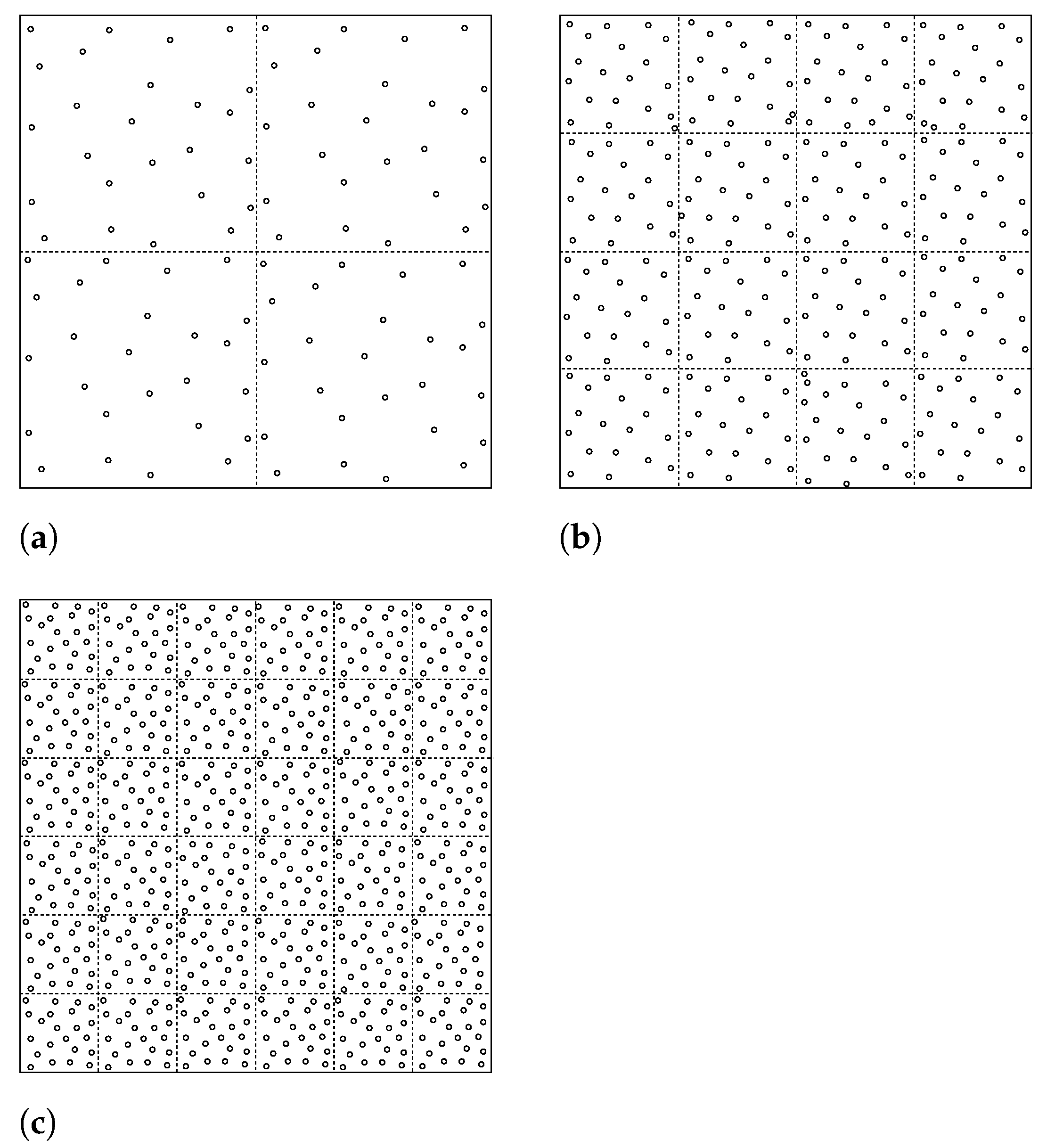
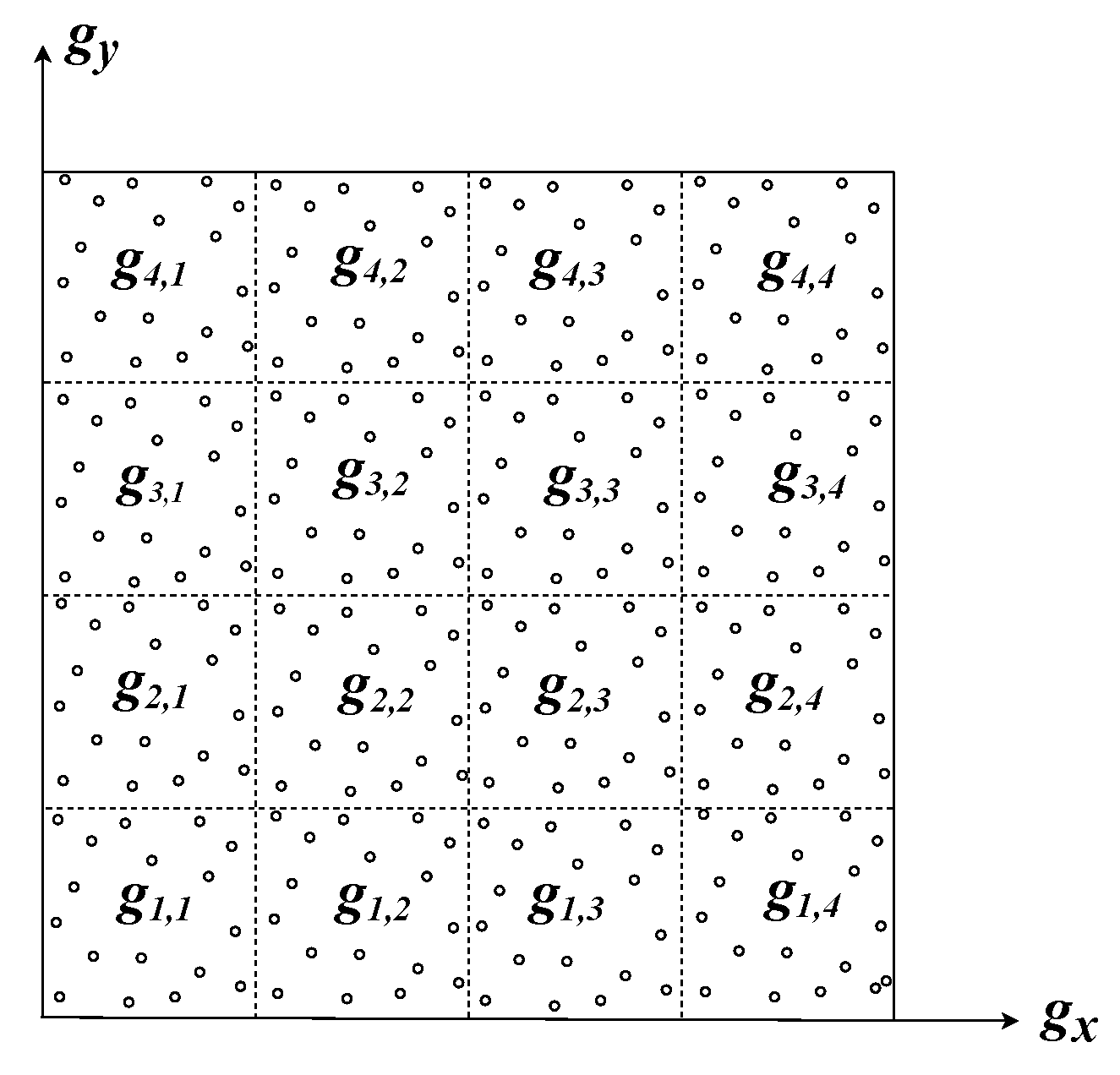

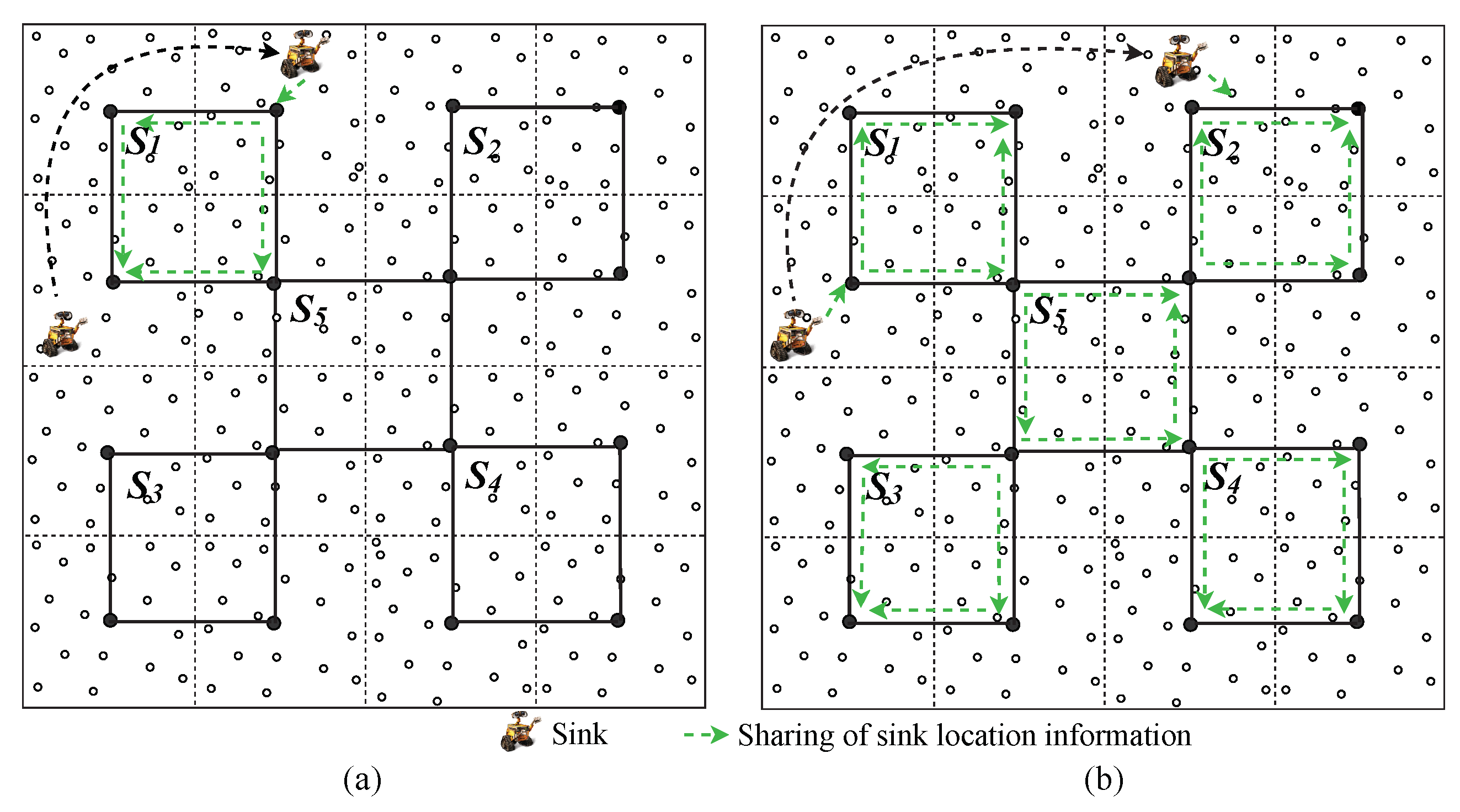
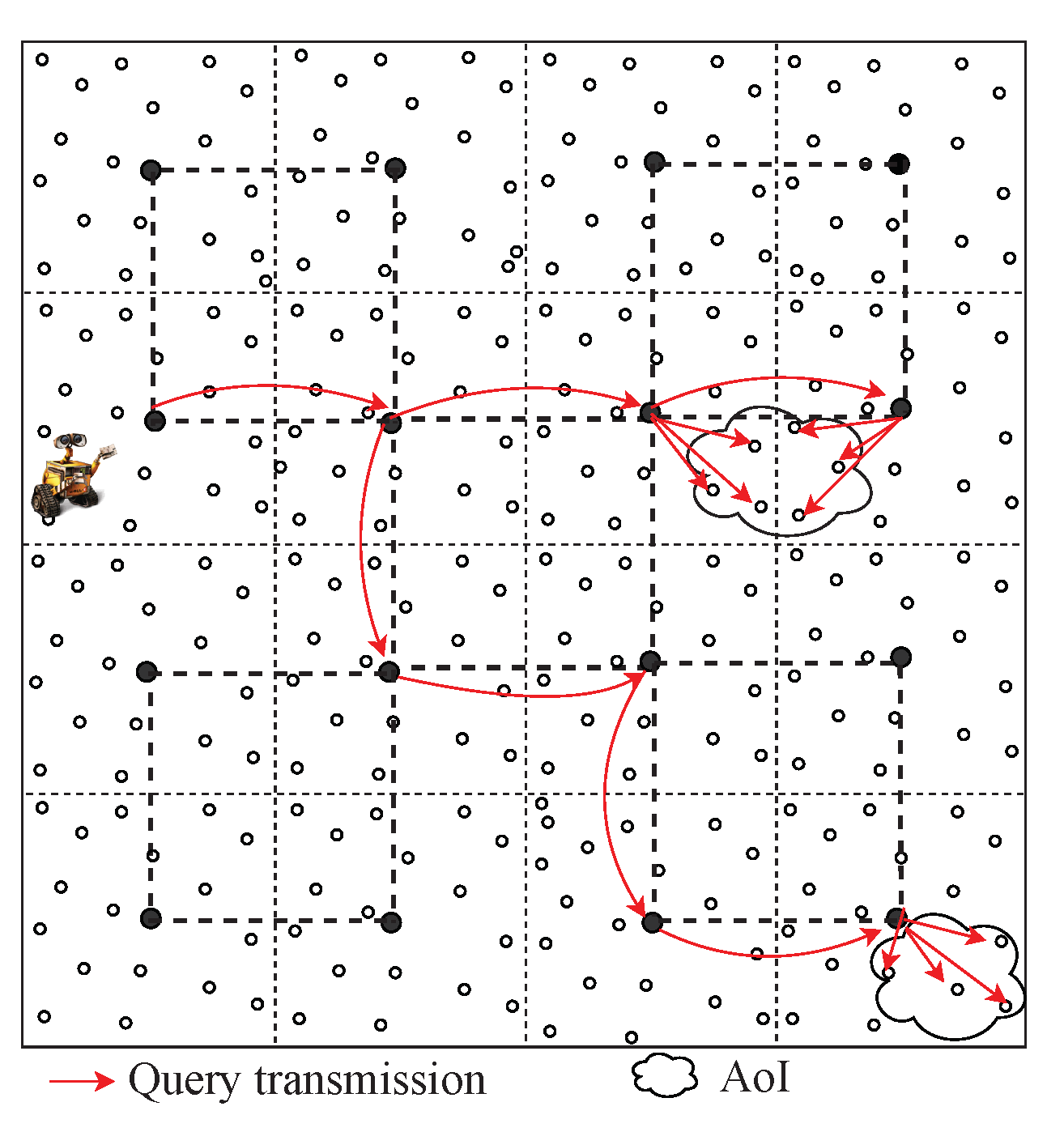

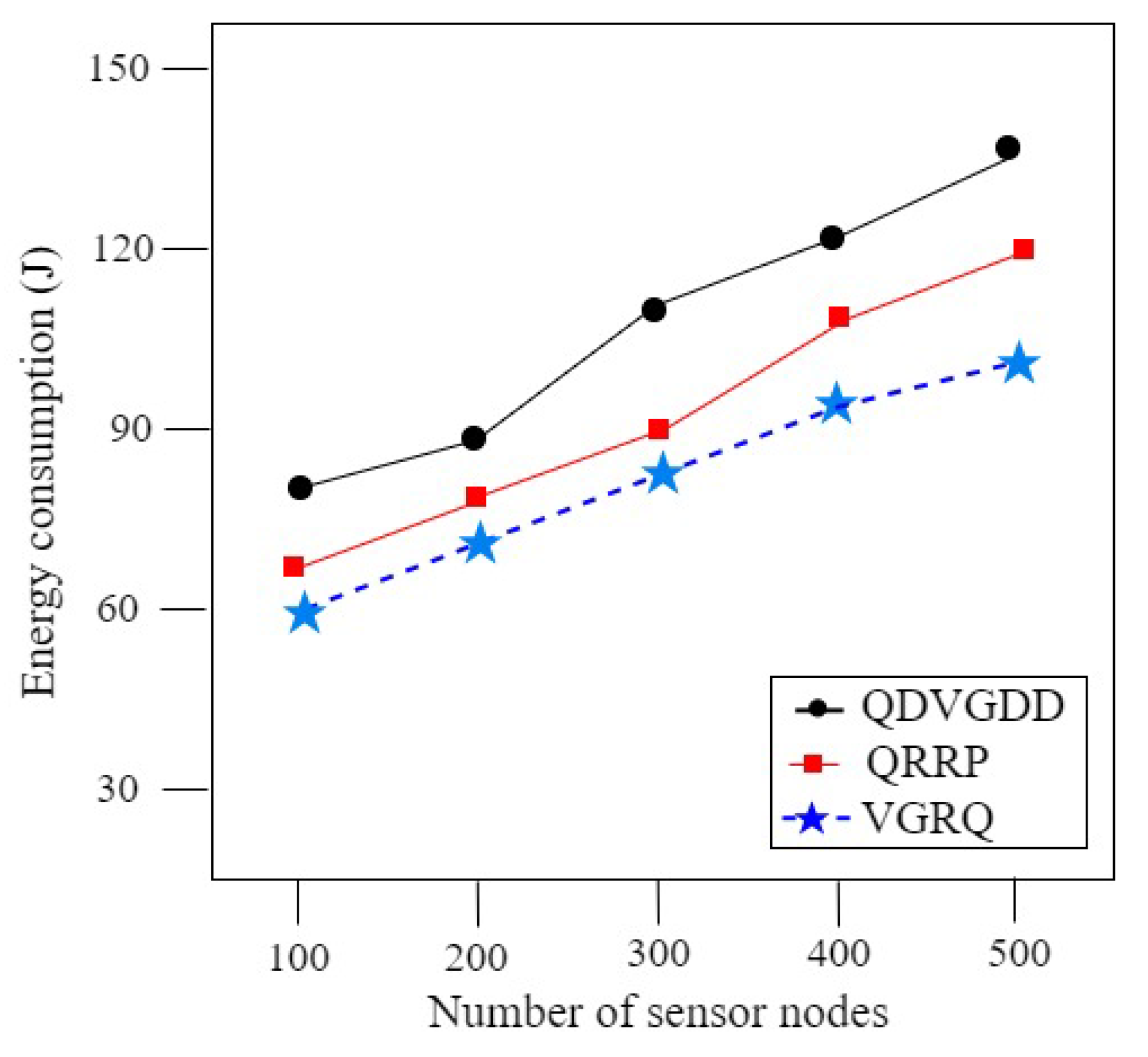
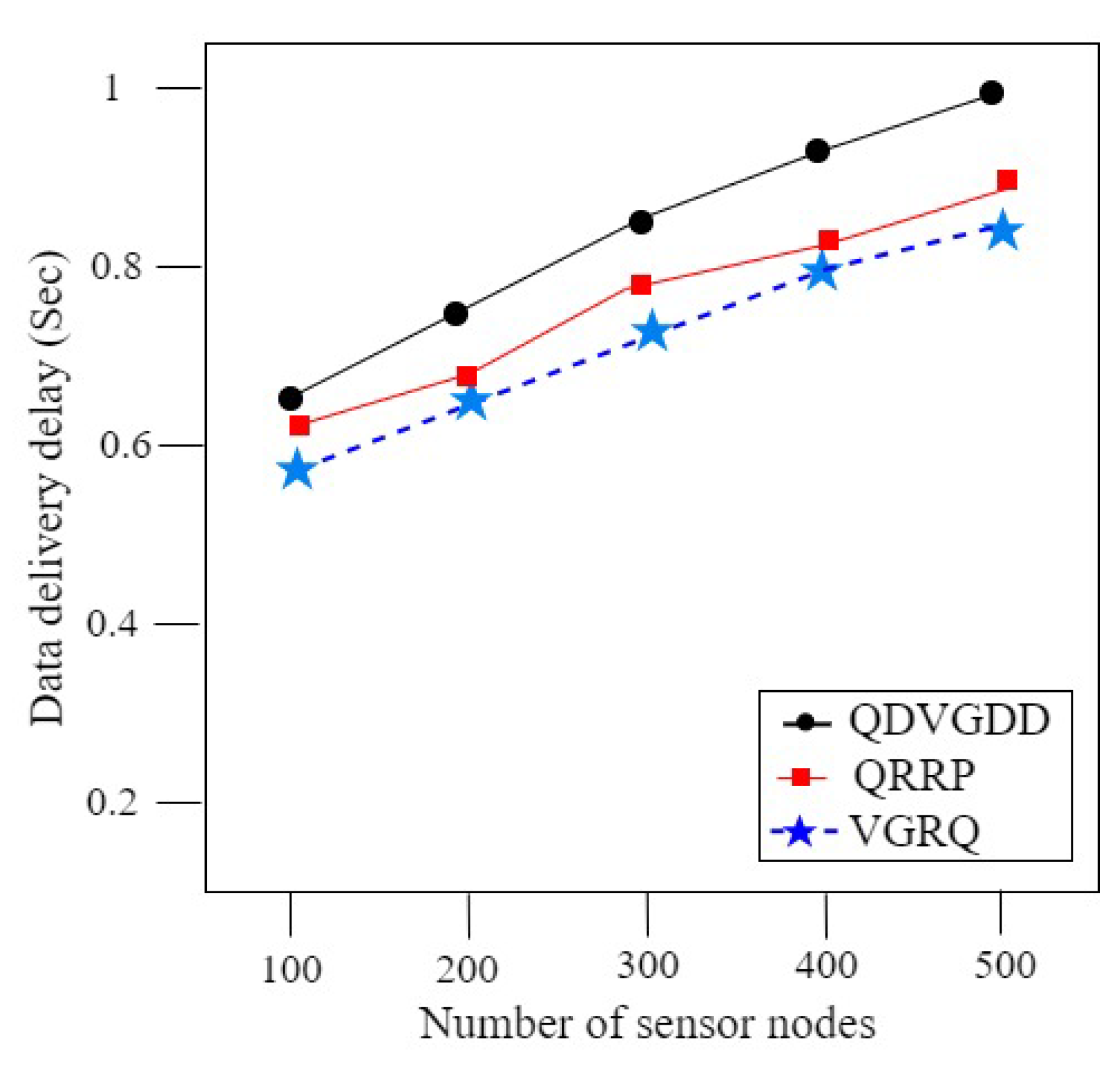

| Routing Technique | Structure Type | Sink Movement Type | Number of Sink(s) | Data Transmission Mode |
|---|---|---|---|---|
| HexDD [18] | Grid | Random | Multiple | Query |
| RDDM [19] | Cluster | Random | Multiple | Query |
| QDVGDD [20] | Grid | Fixed | One | Query |
| EDEDA [21] | Grid | Fixed | One | Event |
| TARA [22] | Grid | Pre-defined | One | Event |
| QRRP [23] | Ring | Random | One | Query |
| QBR [24] | Backbone | Random | One | Query |
| VGRQ (proposed) | Grid | Random | One | Query |
| Parameters | Values |
|---|---|
| Number of sensor nodes | 100–500 |
| Initial Energy | 15 J |
| Area of sensor network | 400 × 400 m2 |
| Transmission range of sensor nodes | 50 m |
| Sink movement | Random |
| Data packet size | 512 B |
Disclaimer/Publisher’s Note: The statements, opinions and data contained in all publications are solely those of the individual author(s) and contributor(s) and not of MDPI and/or the editor(s). MDPI and/or the editor(s) disclaim responsibility for any injury to people or property resulting from any ideas, methods, instructions or products referred to in the content. |
© 2023 by the authors. Licensee MDPI, Basel, Switzerland. This article is an open access article distributed under the terms and conditions of the Creative Commons Attribution (CC BY) license (https://creativecommons.org/licenses/by/4.0/).
Share and Cite
Jain, S.K.; Bhatia, R.; Shrivastava, N.; Salunke, S.; Hashmi, M.F.; Bokde, N.D. Virtual Grid-Based Routing for Query-Driven Wireless Sensor Networks. Future Internet 2023, 15, 259. https://doi.org/10.3390/fi15080259
Jain SK, Bhatia R, Shrivastava N, Salunke S, Hashmi MF, Bokde ND. Virtual Grid-Based Routing for Query-Driven Wireless Sensor Networks. Future Internet. 2023; 15(8):259. https://doi.org/10.3390/fi15080259
Chicago/Turabian StyleJain, Shushant Kumar, Rinkoo Bhatia, Neeraj Shrivastava, Sharad Salunke, Mohammad Farukh Hashmi, and Neeraj Dhanraj Bokde. 2023. "Virtual Grid-Based Routing for Query-Driven Wireless Sensor Networks" Future Internet 15, no. 8: 259. https://doi.org/10.3390/fi15080259
APA StyleJain, S. K., Bhatia, R., Shrivastava, N., Salunke, S., Hashmi, M. F., & Bokde, N. D. (2023). Virtual Grid-Based Routing for Query-Driven Wireless Sensor Networks. Future Internet, 15(8), 259. https://doi.org/10.3390/fi15080259










